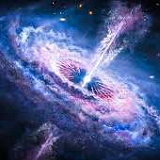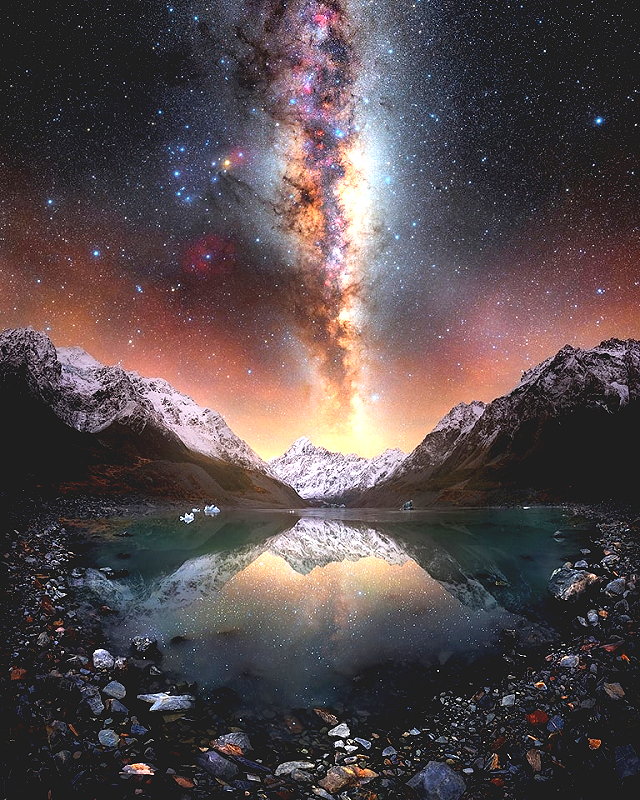
|
Milky Way Universe Last Updated: 01/14/2025 |
| The Milky Way is the galaxy that contains our solar system. It's a barred spiral galaxy, meaning it has a central bar-shaped structure composed of stars. The Milky Way spans about 100,000–200,000 light-years in diameter. It contains approximately 100–400 billion stars. Its mass is estimated to be about 1.5 trillion times the mass of the Sun, most of which is dark matter. | |
| - Located in the direction of the constellation Sagittarius. The Milky Way hosts a supermassive black hole known as Sagittarius A. The Milky Way has several spiral arms, where stars, gas, and dust are concentrated. Our solar system is located in the Orion Arm, about 27,000 light-years from the galactic center. A roughly spherical region surrounding the galaxy, it contains older stars and globular clusters. - The Milky Way is moving through space at about 600 km/s relative to the cosmic microwave background radiation. It is part of a group of galaxies called the Local Group, which includes the Andromeda Galaxy (our closest large galactic neighbor). - From Earth, the Milky Way appears as a dense band of stars across the sky, visible in dark-sky areas without significant light pollution. This band is the dense collection of stars and material that makes up the galactic plane. | |
Website Wikipedia Facebook
World » Wrd
Place » Space

|
Jupiter Place » Space Jupiter is the largest planet in the solar system and the fifth planet from the sun. The gas giant has a long, rich, history of surprising scientists. Jupiter has 79 moons and is known as the 'king of the planets'. Jupiter orbits the Sun at a distance of 5.20 AU (778.5 Gm) with an orbital period of 11.86 years. 57 views 💖 1Jupiter |

|
Mars Place » Space Mars is the fourth planet from the sun and has a distinct rusty red appearance and two unusual moons. The Red Planet is a cold, desert world within our solar system. It has a very thin atmosphere, but the dusty, lifeless planet is far from dull. The surface of Mars is orange-red because it is covered in iron oxide dust, giving it the nickname "the Red Planet". 55 views 💖 1Outer Space |

|
Saturn Place » Space Saturn is the sixth planet from the Sun and the second-largest in the Solar System, after Jupiter. It has a whopping 145 moons. It's the farthest planet from Earth that's visible to the unaided eye, but the planet's most outstanding features — its rings — are better viewed through a telescope. It is a gas giant with an average radius of about nine-and-a-half times that of Earth. 56 views 💖 1Universe |

|
Bennu Place » Space 101955 Bennu is a carbonaceous asteroid in the Apollo group discovered by the LINEAR Project on 11 September 1999. It is a potentially hazardous object that is listed on the Sentry Risk Table and has the highest cumulative rating on the Palermo Technical Impact Hazard Scale. Bennu has a 1 in nearly 1,800 chance to hit Earth in the next 300 years. 65 views 💖 1Universe |

|
Mercury Place » Space Mercury is the smallest planet in the Solar System and the closest to the Sun, with a diameter of about 4,880 km. It has a dense metallic core, constituting roughly 75% of its volume, and a thin silicate crust23. Mercury's surface is heavily cratered due to impacts over billions of years, featuring notable formations like the Caloris Basin34. 26 views 💖 1Solar System |

|
Neptune Place » Space Neptune is the eighth and farthest planet from the Sun in our solar system. It’s the fourth-largest, and the first planet discovered with math. The distance is about 4.5 billion kilometers ~2.8 billion miles on average from the Sun. Diameter is approximately 49,244 kilometers ~30,598 miles. The orbit period is 164.8 Earth years and day length is about 16 hours. 33 views 💖 1Solar System |

|
Uranus Place » Space Uranus is the seventh planet from the Sun in our Solar System and is known as an ice giant because it's made of water, ammonia, and methane. It's the third-largest planet by diameter ~50,724 km or 31,518 miles, about four times wider than Earth and the fourth-largest by mass. 28 views 💖 1Solar System |

|
Venus Place » Space Venus is the second planet from the Sun, and the sixth largest planet. It’s the hottest planet in our solar system. It is often called Earth's "sister planet" due to its similar size, mass, and proximity. Early Soviet Venera missions successfully landed on Venus and sent back surface images and data and NASA's Magellan orbiter mapped the surface in the 1990s using radar imaging. 35 views 💖 1Solar System |

|
Universe Place » City The universe is all of space and time and their contents. It comprises all of existence, any fundamental interaction, physical process and physical constant, and therefore all forms of matter and energy, and the structures they form, from sub-atomic particles to entire galactic filaments. 44 views 💖 1Universe |

|
Pluto Place » Space Pluto was once our solar system's ninth planet, but has been reclassified as a dwarf planet. It's located in a distant region of our solar system beyond Neptune known as the Kuiper Belt. Its diameter is about 2,377 kilometers (1,477 miles), smaller than Earth's Moon. Orbit is highly elliptical and inclined, taking 248 Earth years to complete one orbit around the Sun. Sometimes it is closer to the Sun than Neptune. 33 views 💖 1Solar System |
Write a Review :
Milky Way
|
|
